Download PDF
Download page Configuring Time Series Icon Properties.
Configuring Time Series Icon Properties
After you have created time series icons, you must configure the properties of each time series icon individually in the Time Series Icon Editor dialog. Properties include the name of the icon, the location of the data, and the appearance of the time series icon in the different modules. You can also set up images, web pages, webcams, documents, and scripting information associated with the time series icon.
Naming a Time Series Icon
To give a time series icon a name, description, and icon symbol:
- Using the Time Series Icon Tool, right-click the time series icon you want to name. From the shortcut menu, click Rename. The Rename Time Series Icon dialog opens.
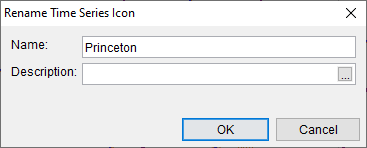
- Enter the new name in the Name field (and a description in the Description field if desired) and click OK.
Associating Data with a Time Series Icon
Within CWMS, time series data can be accessed from either the CWMS database, the CWMS Data API, or an HEC-DSS file.
CWMS Database
To associate data from the CWMS database:
- From the Time Series Icon Editor dialog, from the Data Menu, select Browse CWMSVue.
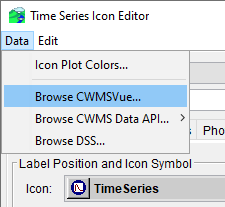
- The Select Time Series Identifiers dialog will open and will be connected to the CWMS database you have previously logged into.
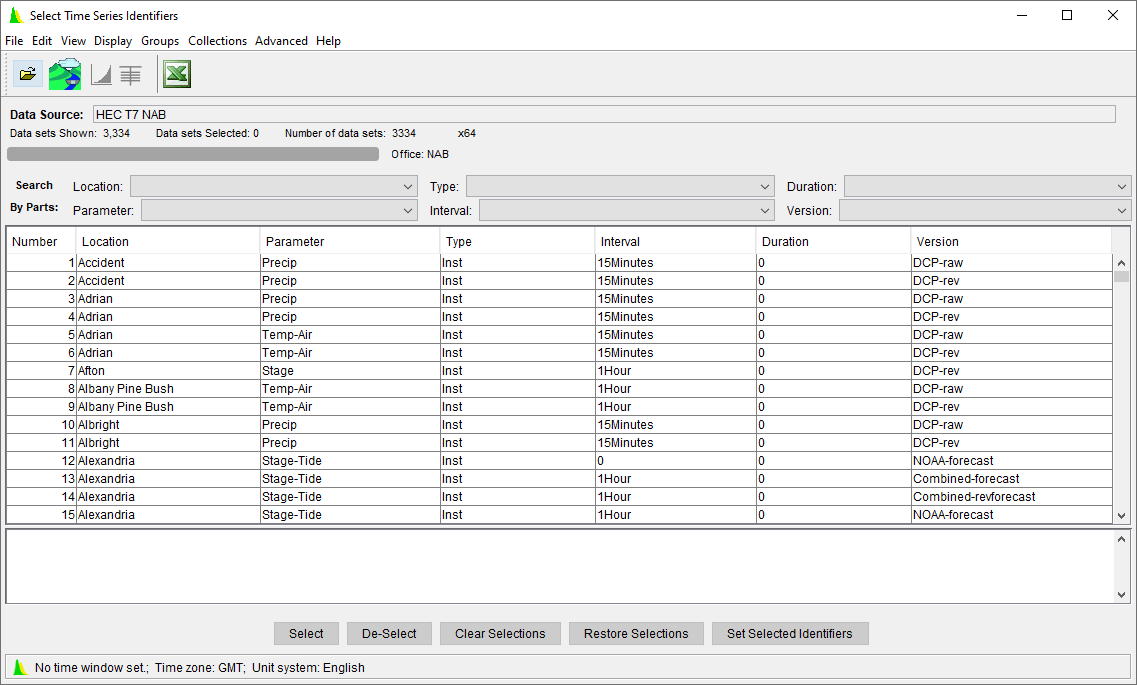
- The table in the dialog displays the available time series identifiers in the CWMS database.
To add time series data sets, highlight the time series identifiers in the table by clicking on the row(s), and click Select. Your selection will display in the selection list below the table. Continue adding identifiers by selecting them in the table and clicking Select. You can also double-click a selection to add or remove it from the selection list.
To search the CWMS identifiers, use the Search By Parts Lists. Here the data can be filtered by the following categories:
Location - physical location of the gage
- Parameter - type of gage, such as precipitation or temperature
- Type - type of reading, such as instantaneous, total (cumulative), maximum, minimum, average, or constant
- Interval - interval between readings, or how often readings are taken
- Duration - the length of time over which each value represents (daily average readings may be computed several times a day, instantaneous readings have a duration of zero)
- Version - further identification of the data (raw, revised, USGS, NOAA, NWS, etc.)
Once you have chosen your time series identifiers, click Set Selected Identifiers. The dialog closes and the Time Series Icon Editor dialog will display the pathnames you have selected in the Associated Data Sets table.
CWMS Data API
Before you can access data using the CWMS Data API, you will need to configure the connection through the CWMS Login Setup dialog.
To associate data using the CWMS Data API:
- From the Time Series Icon Editor, select Browse CWMS Data API and choose the appropriate server.
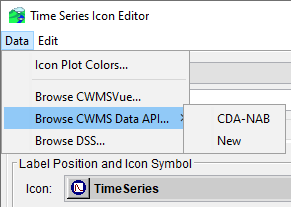
- The Select Time Series Identifiers dialog will open.
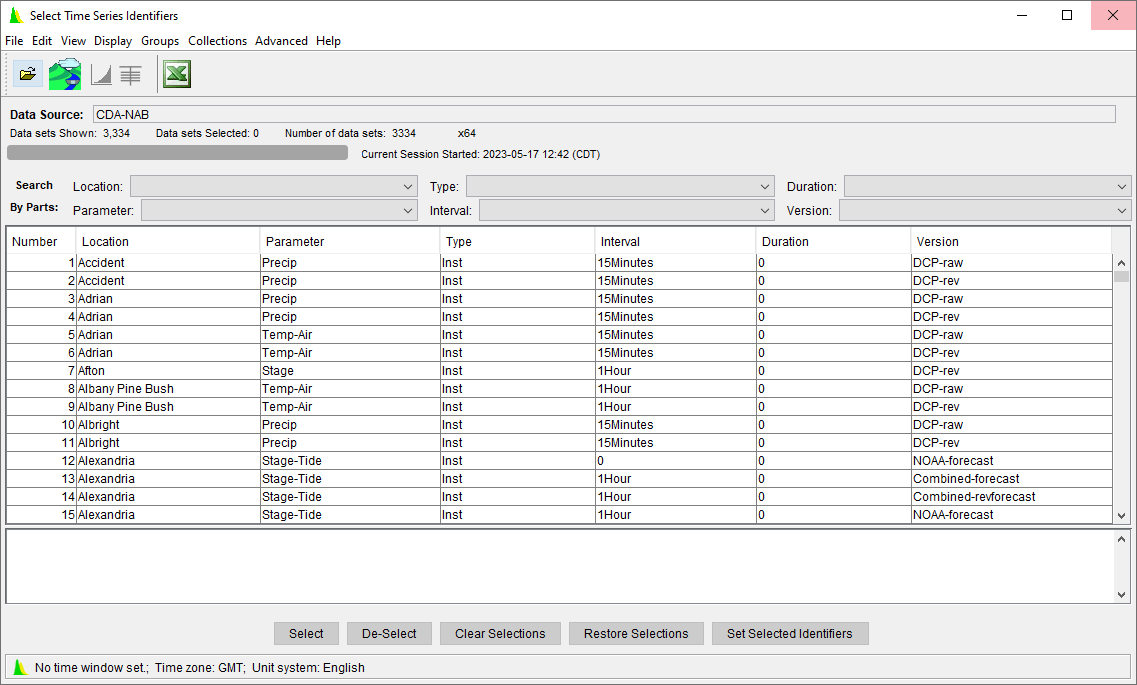
- To add time series data sets, highlight the time series identifiers in the table by clicking on the row(s), and click Select. Your selection will display in the selection list below the table. Continue adding identifiers by selecting them in the table and clicking Select. You can also double-click a selection to add or remove it from the selection list.
- Once you have chosen your time series identifiers, click Set Selected Identifiers. The dialog closes and the Time Series Icon Editor dialog will display the pathnames you have selected in the Associated Data Sets table.
HEC-DSS File
Before associating data from a DSS file, you need to have a DSS file available. A good choice for icons intended for use in the Modeling module is the DSS file from the active CWMS forecast (forecast.dss). Note that references to forecast.dss are not supported in the Acquisition and Visualization modules since they do not maintain associations with active forecasts.
To associate data from an HEC-DSS file:
- From the Time Series Icon Editor, select Browse DSS from the Data menu.
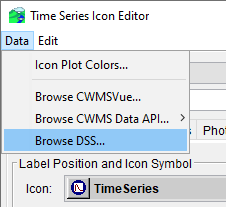
- The Select Pathnames dialog opens. From the File menu, select Open. The Open HEC-DSS File dialog opens.
- Browse to the location of the appropriate DSS file, select the DSS file, and click Open. The Open HEC-DSS File dialog will close. Once the file has been opened, the table in the Select Pathnames dialog displays the available pathnames.
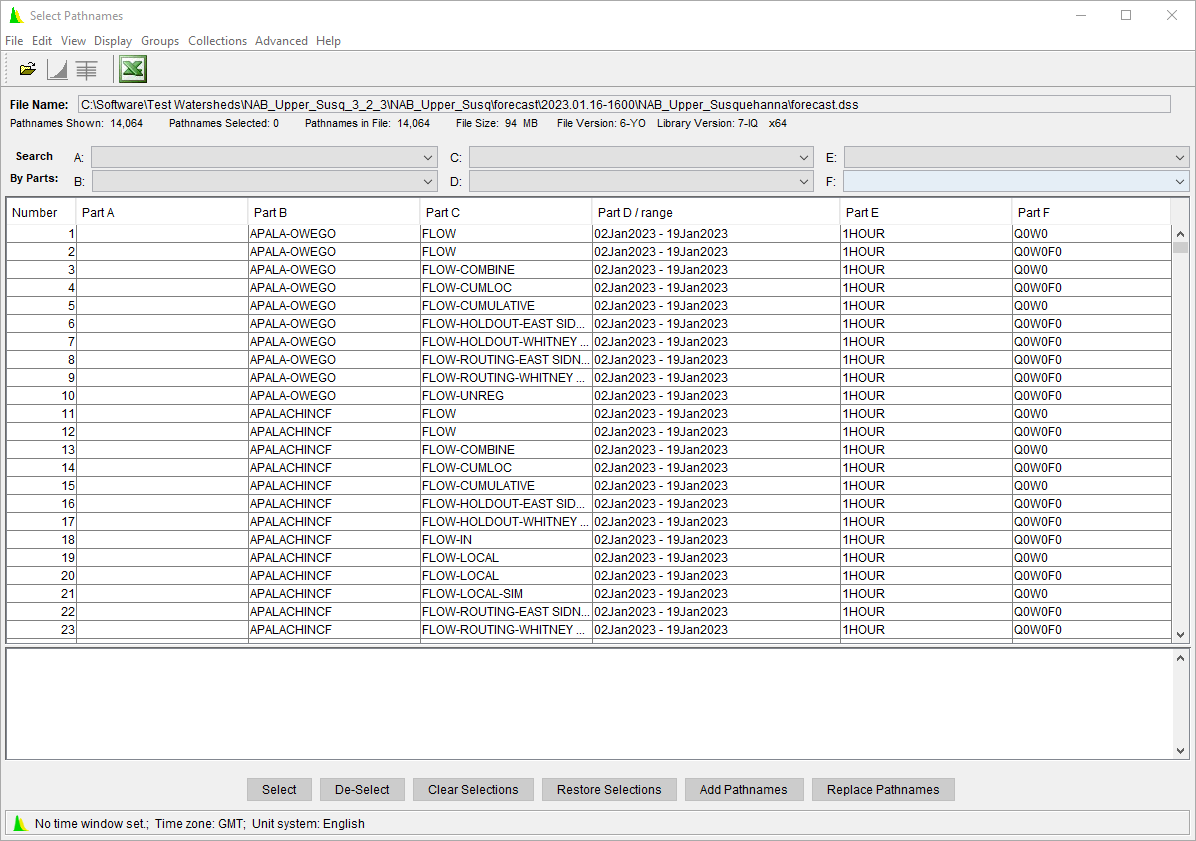
- Find the pathname you wish to add to your time series icon and select it using the Select button. The pathname displays in the selection area below the table. Repeat this step until you have selected all of the pathnames that are needed.
- Once you are finished selecting pathnames, click Add Pathnames. If the pathnames are from modeling output, a message box will appear asking "Do you want model F parts set to %'s (to correspond to the alternatives selected)?". Click Yes. This will replace the F parts with percent sign wild characters that will be substituted with the forecast key when displaying modeling results. A single percent sign represents one model output in sequence, so "%%" will correspond to HEC-HMS output, and "%%%" will correspond to output from HEC-ResSim. Pathnames with an F part of OBS will not have their F parts replaced with percent signs.
- From the File menu, click Close. The Select Pathnames dialog will close and the pathnames you selected will display in the Associated Data Sets table of the Time Series Icon Editor dialog. Click OK.
Removing Data from a Time Series Icon
To remove data from a time series icon:
- From the Time Series Icon Editor, select a row(s) from the Associated Data Sets Table that contains the data you no longer want associated with the time series icon.
- From the Edit menu, select Delete Rows. The selected rows will be deleted from the Associated Data Sets table, and the data will no longer be associated with the time series icon.
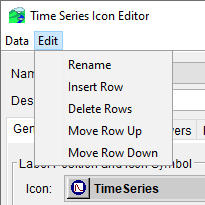
Map Window Attributes for Data
Before you proceed with the next steps, you will need to define Time Series Icon Layers.
Layers
To assign data sets to a time series layer:
- From the Time Series Icon Editor, click the Icon Types and Layers tab.
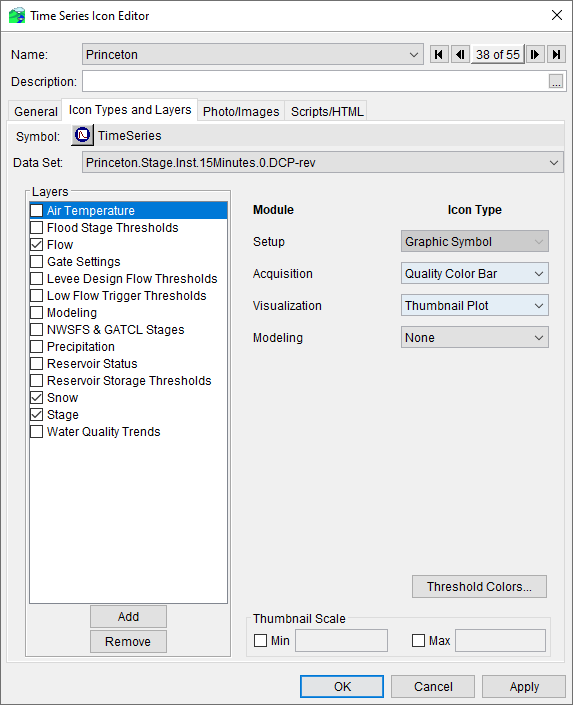
- From the Data Set list, select the data set you wish to assign to a time series icon sub-layer. From the Layers field, select or clear the appropriate sub-layers for the selected data set. Click Apply to save any changes.
Icon Types
There are seven icon types to choose from. The following is a description of each of the available types:
![]() Graphic Symbol - Graphic symbols provide an at-a-glance reference to the type of location represented and allow direct access to data associated with a location (such as model results). Selecting this option displays the graphic symbol as it was defined for the time series icon in the Setup module.
Graphic Symbol - Graphic symbols provide an at-a-glance reference to the type of location represented and allow direct access to data associated with a location (such as model results). Selecting this option displays the graphic symbol as it was defined for the time series icon in the Setup module. ![]()
![]() Dot - Dots allow you to mark gages and time series locations without cluttering the map display. Selecting this option displays a small red dot along with the icon label () in the display area.
Dot - Dots allow you to mark gages and time series locations without cluttering the map display. Selecting this option displays a small red dot along with the icon label () in the display area. ![]() Thumbnail Plot - Thumbnail plots are miniature versions of the full-size plots available in CWMS, showing data for the duration of the time window. As the time window updates, CWMS refreshes the data and updates the plot. Thumbnail plots offer a quick overview of current data for the selected time window.
Thumbnail Plot - Thumbnail plots are miniature versions of the full-size plots available in CWMS, showing data for the duration of the time window. As the time window updates, CWMS refreshes the data and updates the plot. Thumbnail plots offer a quick overview of current data for the selected time window. ![]() Quality Color Bar - Quality color bars are linear histograms that offer a quick view of the quality of incoming data within the time window you have set. A CWMS database process (DATCHK) evaluates incoming data and assigns a flag to the data. Color bars reflect this quality check by displaying bands of color that display quality information for data sets that are configured for the icon. Color schemes can be configured for the quality colors in the Data Acquisition Module.
Quality Color Bar - Quality color bars are linear histograms that offer a quick view of the quality of incoming data within the time window you have set. A CWMS database process (DATCHK) evaluates incoming data and assigns a flag to the data. Color bars reflect this quality check by displaying bands of color that display quality information for data sets that are configured for the icon. Color schemes can be configured for the quality colors in the Data Acquisition Module. ![]() Threshold Color Bar - Threshold color bars are linear histograms that compare incoming data against threshold values set for a location. For example, at a flow location, green might be assigned to flow values less than 5,000 cfs, which represent normal flow conditions. Yellow may represent values greater than 5,000 cfs, but less than 7,000 cfs to indicate flows in a flood warning level, and red may represent values greater than 7,000 cfs to indicate flows above flood stage. Because threshold color bars are location dependent, you must set the values for each time series icon individually.
Threshold Color Bar - Threshold color bars are linear histograms that compare incoming data against threshold values set for a location. For example, at a flow location, green might be assigned to flow values less than 5,000 cfs, which represent normal flow conditions. Yellow may represent values greater than 5,000 cfs, but less than 7,000 cfs to indicate flows in a flood warning level, and red may represent values greater than 7,000 cfs to indicate flows above flood stage. Because threshold color bars are location dependent, you must set the values for each time series icon individually. ![]() Cumulative Threshold Color Bar - Cumulative threshold color bars are color bars that display accumulated values. For example, display precipitation over time or the sum of volumes of inflows to a lake are accumulated values.
Cumulative Threshold Color Bar - Cumulative threshold color bars are color bars that display accumulated values. For example, display precipitation over time or the sum of volumes of inflows to a lake are accumulated values.
None - By selecting None, you can configure the icon to not display on the map window for a specific module. This is useful when you only use an icon in a specific module, as it keeps the map display uncluttered with unnecessary icons.
To associate the data sets to CWMS modules:
- From the Icon Type list for each module, select an icon type for the data set.
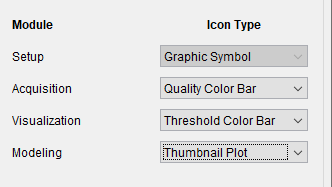
- The selected data set will appear in the Setup module as a graphic symbol, in the Acquisition module as a quality color bar, in the Visualization module as a threshold color bar, and in the Modeling module as a thumbnail plot.
- Once you are finished with the setup of the time series icon, click OK. The Time Series Icon Editor dialog will close.